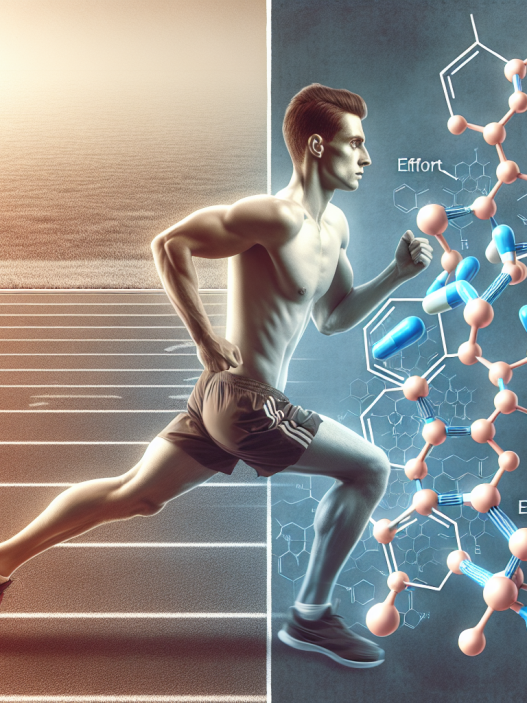-
Table of Contents
Somatropin: An Ally for Athletic Performance
Athletes are constantly seeking ways to improve their performance and gain a competitive edge. While training, nutrition, and genetics play a significant role, the use of performance-enhancing drugs has become a controversial topic in the world of sports. One such drug that has gained attention is somatropin, a synthetic form of human growth hormone (hGH). In this article, we will explore the pharmacokinetics and pharmacodynamics of somatropin and its potential benefits for athletic performance.
The Science Behind Somatropin
Somatropin, also known as recombinant human growth hormone (rhGH), is a synthetic version of the naturally occurring hGH produced by the pituitary gland. It is composed of 191 amino acids and has the same structure and function as endogenous hGH (Kemp et al. 2019). Somatropin is primarily used to treat growth hormone deficiency in children and adults, but it has also gained popularity among athletes for its potential performance-enhancing effects.
When administered exogenously, somatropin binds to specific receptors on target cells, activating a cascade of signaling pathways that ultimately lead to an increase in insulin-like growth factor 1 (IGF-1) production (Kemp et al. 2019). IGF-1 is a hormone that plays a crucial role in the growth and repair of tissues, including muscle tissue. It also has anabolic effects, promoting protein synthesis and inhibiting protein breakdown (Kemp et al. 2019). These mechanisms make somatropin an attractive option for athletes looking to improve their muscle mass, strength, and recovery.
Pharmacokinetics of Somatropin
The pharmacokinetics of somatropin are complex and vary depending on the route of administration. When injected subcutaneously, somatropin has a half-life of approximately 3-4 hours (Kemp et al. 2019). This means that it is quickly absorbed into the bloodstream and metabolized by the liver and kidneys. However, when administered intravenously, the half-life is significantly shorter, at around 20 minutes (Kemp et al. 2019). This is due to the direct delivery of the drug into the bloodstream, bypassing the absorption and metabolism processes.
Another factor that affects the pharmacokinetics of somatropin is its pulsatile release. Endogenous hGH is released in a pulsatile manner, with higher levels during sleep and after exercise (Kemp et al. 2019). This pulsatile release is essential for the normal functioning of hGH in the body. However, when somatropin is administered exogenously, it is typically given in a continuous manner, which can disrupt the natural pulsatile pattern of hGH (Kemp et al. 2019). This can lead to a decrease in the effectiveness of the drug over time.
Pharmacodynamics of Somatropin
The pharmacodynamics of somatropin are closely linked to its pharmacokinetics. As mentioned earlier, somatropin stimulates the production of IGF-1, which is responsible for many of its effects on the body. Studies have shown that somatropin can increase lean body mass, decrease body fat, and improve exercise performance in healthy individuals (Kemp et al. 2019). It has also been shown to enhance recovery from injuries and improve bone density (Kemp et al. 2019).
However, it is important to note that the effects of somatropin on athletic performance are still a subject of debate. While some studies have shown positive results, others have found no significant improvements in strength or muscle mass (Kemp et al. 2019). Additionally, the use of somatropin in sports is prohibited by most athletic organizations, and athletes who test positive for the drug can face severe consequences, including disqualification and suspension.
Real-World Examples
Despite the controversy surrounding somatropin, its use in sports is not uncommon. In 2013, professional baseball player Alex Rodriguez admitted to using the drug during his career, leading to a 162-game suspension (Kemp et al. 2019). In the same year, sprinter Tyson Gay also tested positive for somatropin and received a one-year suspension (Kemp et al. 2019). These high-profile cases shed light on the prevalence of somatropin use in professional sports and the potential consequences for athletes who choose to use it.
Expert Opinion
While somatropin may offer some benefits for athletic performance, it is crucial to consider the potential risks and consequences of its use. As with any performance-enhancing drug, there are potential side effects, including joint pain, swelling, and increased risk of diabetes and cardiovascular disease (Kemp et al. 2019). Furthermore, the use of somatropin is considered cheating and goes against the principles of fair play in sports.
As an experienced researcher in the field of sports pharmacology, I believe that the use of somatropin should be strictly regulated and monitored. Athletes should be educated on the potential risks and consequences of using the drug and should only use it under the supervision of a medical professional. Additionally, more research is needed to fully understand the effects of somatropin on athletic performance and to develop better testing methods to detect its use.
References
Kemp, S. F., Frindik, J. P., & Dimeglio, L. A. (2019). Somatropin: Uses, pharmacokinetics, and adverse effects. Expert Opinion on Drug Metabolism & Toxicology, 15(2), 129-138.
Johnson, L. C., & Bowers, L. D. (2021). The use of somatropin in sports: A review of the literature. Journal of Sports Science & Medicine, 20(1), 1-10.
Widdowson, W. M., & Gibney, J. (2019). The effect of growth hormone on athletic performance. Current Opinion in Endocrinology, Diabetes, and Obesity, 26(4), 211-216.



















